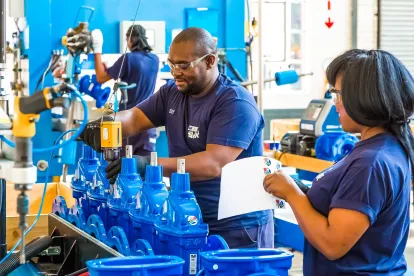With the “Great Resignation” reportedly affecting the manufacturing sector more than other sectors, many manufacturers need to work harder than ever to find and keep qualified workers. This problem is compounded when business is growing, as is the case for some manufacturing companies. To address these obstacles, businesses should consider adjusting their hiring strategies and finding ways to adopt a more employee-friendly work culture.
Adjusting Hiring Strategies
-
Streamline hiring. Traditionally, the hiring process involved a careful, perhaps slow, review of an applicant’s qualifications, including one or more interviews with decisionmakers. Manufacturers often can work faster to get applicants a quicker decision. Consider holding jobs fairs, perhaps at the facility, with all necessary decisionmakers present. After a preliminary applicant screening, initial job offers often can be made on the spot, pending a successful background check, as necessary.
-
Make a recruitment video. Long before applying, potential workers are surfing the internet for insight on potential employers. One multimedia option is to post a recruitment video on the company website. One commentator has even prepared a sample script for manufacturers.
-
Cast a wider net. Recruiters and HR professionals may advertise jobs more creatively to reach a wider audience by building partnerships with multicultural professional associations, nonprofits, trade associations, and academic institutions. In addition, manufacturers can look for talent internationally, leveraging immigration to fill labor gaps.
-
Increase pay. Wages for some manufacturing employees had stagnated for years but have been growing with inflation of late for many companies. Increasing pay is often difficult, but some companies are bridging this gap with hiring bonuses that are repayable if the employee quits early.
-
Improve onboarding. Many industries, not just manufacturing, can stand to improve their onboarding processes and first impressions. Businesses should consider improving their onboarding steps and communications to ensure new hires are happy, know where to find key information, and meet management expectations during this transition. Many employees are lost during the first 90 or 180 days. Minimizing that loss is key to ramping up workforces.
Improving the Work Culture
-
Promote diversity, equity, and inclusion (DEI). These are not corporate buzzwords. According to a January 2022 study published in the MIT Sloan Management Review, the failure to promote diversity, equity, and inclusion is contributing significantly to the perception of a “toxic” work culture, which the study concludes is the strongest predictor of turnover during the Great Resignation. Manufacturers should consider implementing or strengthening DEI programs.
-
Enforce COVID-19 and other safety policies. With the Omicron variant of COVID-19 in the news, many manufacturing employees are concerned about exposure at work. Manufacturers should remain vigilant in their efforts to address workplace hazards proactively. The U.S. Supreme Court has blocked the Occupational Safety and Health Administration’s Emergency Temporary Standard on COVID-19 (the “vaccine or test” rule) for employees of large companies. Still, companies should consider taking relatively simple steps to improve COVID-19 safety by consistently enforcing masking policies, increasing airflow in the building, maintaining social distancing, and the like. In some instances, employers may find issuing their own mandates in most states where it is allowed will increase, rather than hurt, their appeal to employees. Manufacturers can try some practical strategies to manage COVID-19 testing and vaccine mandates.
-
Offer lateral opportunities. The study in the MIT Sloan Management Review noted, “Lateral career opportunities are 12 times more predictive of employee retention than promotions.” Some employees just need a new challenge, not a new employer.
-
Make predictable work schedules. The study also found that, for blue-collar employees, “[h]aving a predictable schedule is six times more powerful in predicting front-line employee retention than having a flexible schedule.”
-
Consider remote work, if possible. Unlike employees in other sectors, blue-collar manufacturing workers typically cannot work remotely because they need to be physically present on the factory floor to do their jobs. But, to the extent that remote work or hybrid or flexible work arrangements are possible, especially for front office employees, companies should consider offering that flexibility.





 />i
/>i

